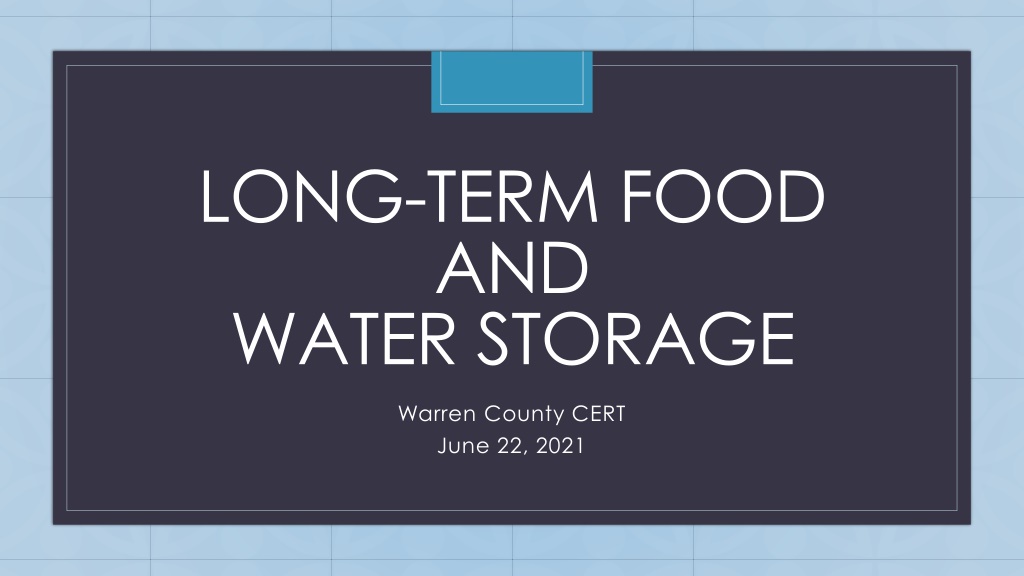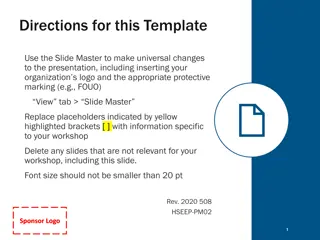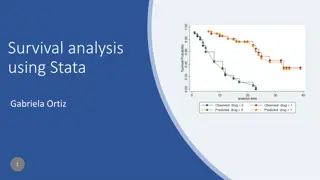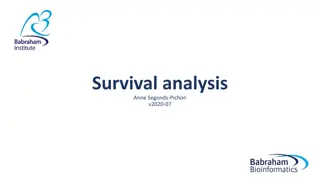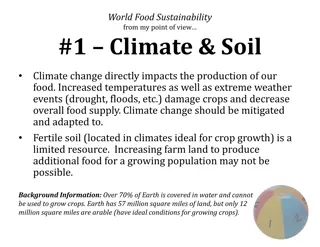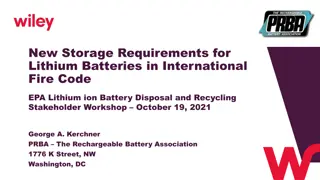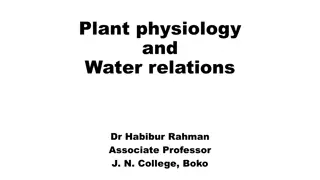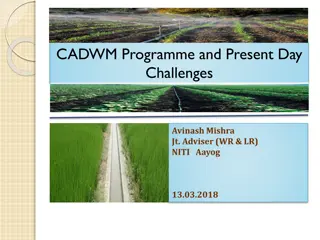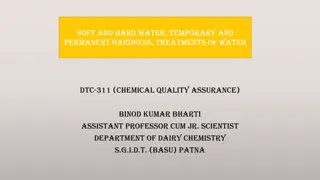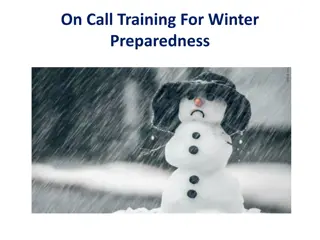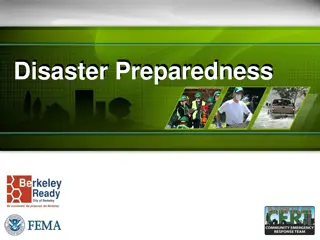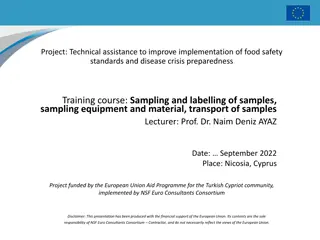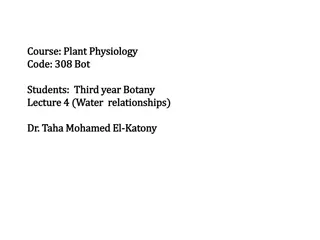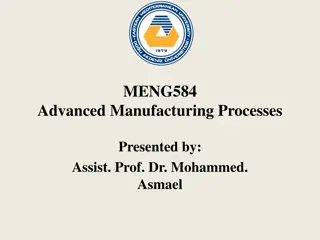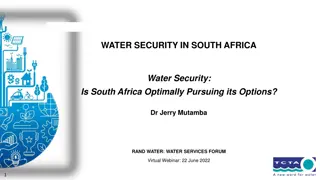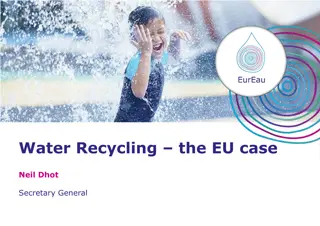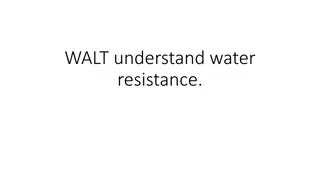Long-Term Food and Water Storage for Survival Preparedness
Explore the essentials of long-term food and water storage for emergency preparedness. Learn how to create a plan, choose the right foods, store them effectively, and preserve them for extended shelf life. Discover tips and methods like vacuum sealing, oxygen absorbers, and freezing to ensure your survival food remains nutritious and palatable. Be ready for any situation with a well-thought-out storage strategy.
Download Presentation

Please find below an Image/Link to download the presentation.
The content on the website is provided AS IS for your information and personal use only. It may not be sold, licensed, or shared on other websites without obtaining consent from the author. Download presentation by click this link. If you encounter any issues during the download, it is possible that the publisher has removed the file from their server.
E N D
Presentation Transcript
LONG-TERM FOOD AND WATER STORAGE C Warren County CERT June 22, 2021
Long-term Food Survival Make a plan and decide how long you want to store food Decide where you are going to store your food Decide what sort of emergencies you might be facing Probably everyone should have a 72-hour emergency supply of food Without a plan you will likely not be successful as it takes resources, determination and space to store food long- term Make a list of foods that you want to store. Your list is part of your plan and is a long-game as it is nearly impossible to gather enough food in a short period of time to store long-term.
Survival Food Food needs to be attractive and exciting. i.e., use different types of grains, legumes and pastas You need variety; not same old; same old Use spices and condiments Need essential nutrients If you don t like something now, you will not like it later so don t waste space storing it
Long-term Food Survival Tips Have a manual can opener Need some kind of camp stove, grill, fire pit, etc. Hard to store meat long-term so will need to supplement your protein with canned meats, jerky, protein powder and protein bars. Use a first in first out methodology to make sure you rotate your food goods Moisture, air and microbes affect shelf-life of food
Types of Food Preservation: Vacuum Sealing Reduces air, reduces food spoilage leading to increased shelf life Use a commercial vacuum sealer Place food in a mylar or aluminum bag, place the bag in water, water pressure forces the air out Place bag/bottle in a bucket of dry ice. The carbon dioxide forces out the air
Types of Food Preservation: Oxygen Absorbers More effective than vacuum sealing Contain iron powder but do not allow the powder to escape Buy safe for human use Good for high humidity environments where there is a greater chance of oxidation
Types of Food Preservation: Freezing One of the most effective methods for extending shelf life Keeps meats, dairy, fruits and vegetables good for up to 3 months Texture, taste and nutrients of the food are preserved
Types of Food Preservation: Desiccants Silica gel packets remove moisture unlike oxygen absorbers that remove oxygen Places that have high humidity makes it difficult to remove the moisture from the food
Types of Food Preservation: Pickling Traditional method for preserving fruits and vegetables It does not allow for microbial growth Food is submerged in a liquid containing salt, spices, sugar or citric acid Foods take on a rich concentrated flavor
Types of Food Preservation: Dehydration Removes all moisture from food Used for vegetables, meat, spices and fruit Extends shelf life by reducing microbial growth Taste and texture of food changes Food is kept at such a low temperature that moisture is removed but food is not cooked More surface area (thin slices) more moisture will be removed Thinner makes more crunchy; thicker more chewy Dehydrator works best; direct sunlight only for peppers and a few other vegetables
Types of Food Preservation: Smoking Another form of dehydration but use smoke Usually done for meat Takes a long time
Food Storage Containers: Aluminum Cans Come in various sizes Can be used for dry or low oil shelf stable foods E.g. dried apple slices, dry onions, flour Their downside is rusting in a high humidity environment
Food Storage Containers: Aluminum Foil/Mylar Pouches Come in a variety of sizes Once sealed do not allow moisture insects, light or air to enter Can also place in larger plastic containers to keep rodents away For instance, if properly sealed with an oxidizer packet flour can stay stable for 25 years.
Food Storage Containers: PETE/PET (Polyethylene terephthalate) plastic bottles Good for dry food products Should not use other plastics as they cannot predictably prevent moisture and oxygen Food should only have 10% moisture content or less For instance, popcorn has about 13.5% water content Used soda pop bottles or other PETE/PET bottles that have previously been used for food
Food Storage Containers: Plastic Buckets Use only food-grade plastic buckets that have not been used for other storage These are used for bulk storage of grains or can be used to store mylar pouches When used for grain storage there is a possibility for insect growth if leave in a humid environment for a long duration of time
Food Storage Containers: Glass containers Glass will not react with food Has zero chance of contamination as moisture cannot get through Lids are designed with a sealable gasket Good for storing liquid or dry foods
Water Storage 1 gallon/person/day Bottled water may be easiest and safest Keep at least a 2-week supply If storing non-store-bought water, put in clean, new food-grade containers Water-grade bottle usually blue Use a tightly closed cap with a narrow neck for easier pouring
Sanitizing Water Container Wash the container and rinse with water Sanitize the container with a solution of 1 tsp odorless bleach (5% sodium hypochlorite) in one quart of water Shake the container in all directions to distribute the bleach solution Wait 30 seconds then pour out the bleach solution Let the container air dry or rinse with clean water Pour in your water and close the cap tightly
Pouring Water Make sure you do not contaminate the container when you pour water from it. Do not touch the spout If you use a cup to take out the water from a large container such as a bucket, make sure to sanitize the cup before placing in the water Ensure you do not touch the insides of the container with any part of your body
Label your water container with what it is and a date Water can only be stored around 6 months before it needs to be replaced Keep in a cool place and out of direct sunlight Do not store near other chemicals Never use a container that has been used for other things Safety Tips
Boiling is the simplest and easiest method Water Purifier Has UV, UF and carbon filters to remove impurities Reverse osmosis not used so much anymore Chlorination Mix in tsp (2.5 mL) of unscented, additive-free bleach for every 5 gallons of water. Double the amount of bleach if the water is cloudy or discolored. Let the water sit for half an hour. If you cannot smell a faint chlorine scent, repeat treatment and let sit another 15 minutes. Water Purification Methods In an emergency, you can also disinfect small amounts of water with water purification tablets. However, use these sparingly, as excessive use can impair thyroid function Distillation This is a complicated process that is not easily done at home Solar purification Water is stored in food grade containers and placed in direct sunlight. The containers are placed in a horizontal position and shaken to activate the oxygen
QUESTIONS AND COMMENTS C C
